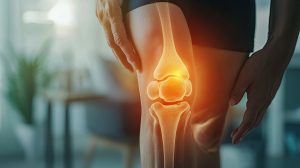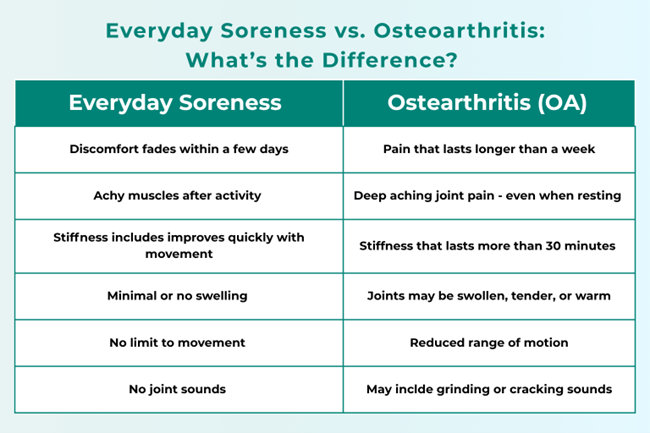Do I Have Osteoarthritis or am I Just Sore?
Is that knee pain just a twinge from your new workout… or is your knee trying to tell you something more serious? Did you tweak your back pulling weeds, or is your spine quietly protesting years of wear and tear?
Many of us experience joint pain or stiffness now and then, and it’s easy to chalk it up to age, activity, or working out too hard. But sometimes, those everyday aches can be an early sign of something more like Osteoarthritis (OA).
So how do you know what’s normal and what’s not? Let’s break down how to tell the difference between typical soreness and OA, when to get a professional opinion, and how it can be treated.
What Exactly Is Osteoarthritis?
Osteoarthritis is the most common type of arthritis and one of the leading causes of disability in adults. Think of osteoarthritis as your joints’ version of a slow, squeaky protest. It happens when the smooth cartilage that cushions your joints starts to wear away. Without that shock absorber, your bones start rubbing together (ouch!), causing pain, swelling, stiffness, and sometimes even grinding or popping noises.
While OA is often called “wear-and-tear” arthritis, it’s not just about getting older. You might be more at risk if you:
- Have a family history of arthritis
- Carry extra weight (more weight = more pressure on joints)
- Have had joint injuries or surgery
- Repetitively use the same joints (hello, tennis elbow or typing wrist)
OA most commonly affects the knees, hips, hands, and spine, all the parts of the body we rely on to move through the day.
Is It Just Soreness, or Something More?
We’ve all felt sore after a long walk, a new workout, or accidentally becoming weekend-warrior royalty during yardwork. OA pain tends to hang around longer and demand more attention. The next time you feel discomfort, ask yourself these questions:
- Does the pain linger even after I rest?
- Is it always in the same joint?
- Does it get worse over time instead of better?
- Do I feel stiff when I wake up or after sitting too long?
If you answered “yes” to any of these, your joints may be trying to tell you something. Let’s break it down.
From Lifestyle Changes to Advanced Solutions
While OA isn’t curable, you can manage it with the right plan and some TLC for your joints.
At OrthoIllinois, we personalize treatment based on your lifestyle, goals, and how your body responds. Whether you’re chasing toddlers, gardening, or golfing 18 holes, we’re here to help you keep moving comfortably.
Non-Surgical Options:
- Lifestyle Changes: Low-impact exercise, ergonomic tools, and healthy weight maintenance
- Physical Therapy: Customized exercises to build strength, flexibility, and reduce pain
- Medications: From anti-inflammatories to pain relievers that help you stay mobile
- Joint Injections: Corticosteroids for flare-ups or hyaluronic acid to lubricate joints
Surgical Options:
When nothing else is providing relief, it may be time to consider procedures like:
- Joint realignment (osteotomy)
- Partial or total joint replacement
Don’t Wait! Get Expert Help and Find Relief
Joint pain might seem like a normal part of life, but you don’t have to accept it. If you’re unsure whether your discomfort is just soreness or something more, trust your gut and talk to a rheumatologist or orthopedic specialist.




